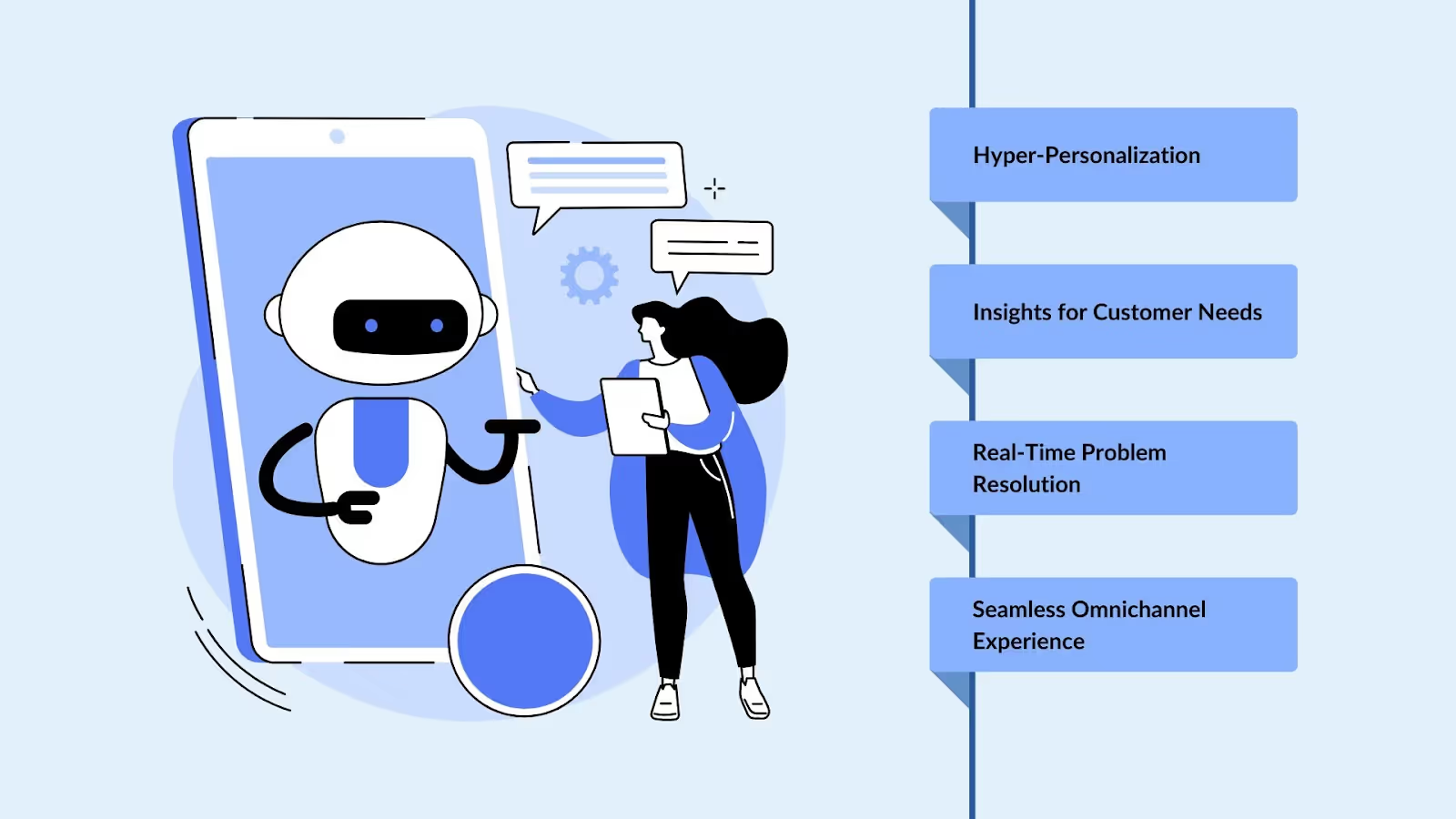Applications of AI in the Future of Banking

Have you ever thought about how AI could change your banking? Imagine a world where your bank understands your financial trends and offers solutions based on your patterns and historical data. This isn't a far-off future but a reality being created by AI in banking today. From intelligent chatbots for better customer service to advanced fraud detection systems for greater security, AI is changing the face of banking. Let's see how these are making banking smarter and more efficient.
Benefits of AI Tools for Banking
1. Improved Customer Service: AI chatbots offer 24/7 support, can handle multiple queries at once, and provide personalized answers. For example, Bank of America's Erica chatbot has increased customer interaction by providing financial advice, transaction
details, and managing card security. (Source)
2. Personalized Banking Experience: AI banking systems analyze customer data to offer personalized services and recommend financial products that can match individual needs, which may potentially lead to increased customer satisfaction and loyalty.
3. Accessibility and Convenience: Voice recognition technology allows customers to interact with their bank accounts through voice commands, making banking more accessible and convenient, especially for visually impaired users.
4. Proactive Customer Retention: AI tools can predict customer churn. Banks can proactively engage with at-risk customers with personalized offers and services to retain them, resulting in higher customer retention rates.
5. Enhanced Feedback Analysis: AI can analyze customer feedback from all channels, social media, and surveys to identify common issues and areas of improvement. This helps banks to improve their services and maintain high customer satisfaction.
6. Real-Time Financial Assistance: AI-powered virtual financial assistants offer real-time financial advice and recommendations based on customers' spending habits and financial goals so they can make better decisions.
Next, we'll delve into specific applications of AI tools in banking, highlighting how these technologies are being employed to transform the industry.
Applications of AI in the Future of Banking
1. Fraud Detection and Prevention: AI platforms for banking are crucial in detecting fraudulent activities. Machine learning algorithms analyze transaction patterns to identify anomalies. HSBC, for instance, uses AI to detect and prevent fraud, improving its fraud detection capabilities.
2. Biometric Security: AI integrates with biometric systems to secure. Facial recognition, fingerprint scanning, and voice recognition are becoming the norm in banking security protocols. These measures not only prevent unauthorized access but also make it easier for legitimate users.
3. Robotic Process Automation (RPA): RPA automates repetitive tasks like data entry, loan processing, and compliance checks. By automating these processes, banks can reduce operational costs and human error. According to Deloitte, banks that have implemented RPA have seen a significant reduction in processing times (Source).
4. AI in Risk Management: AI for banking systems is key to risk management. They analyze market trends and historical data to predict risks. This predictive analysis helps banks make informed decisions and develop strategies to mitigate risks.
5. Automated Credit Scoring: Traditional credit scoring methods are time-consuming and biased. AI tools provide a more accurate and unbiased credit assessment by looking at a wide range of data points, including social media activity and transaction history. This enables banks to lend to a wider audience while minimizing risks.
6. Loan Underwriting: AI speeds up the loan underwriting process by quickly assessing an applicant's creditworthiness. This reduces the time taken to approve loans and improves customer satisfaction and operational efficiency. AI-driven underwriting has been shown to improve the accuracy of loan approvals, potentially reducing loan default rates.
7. AI in Investment Banking: AI for banking will revolutionize investment banking by providing real-time data analysis and predictive insights. This will help in making informed investment decisions, portfolio management, and risk assessment.
8. AI and Blockchain Integration: The integration of AI with blockchain will bring in more security and transparency in banking transactions. AI algorithms can monitor blockchain networks for suspicious activities, thereby potentially enhancing the security and efficiency of transactions.
9. AI in Financial Advisory: AI-driven financial advisory services will provide personalized investment advice based on individual financial goals and risk tolerance. These tools will analyze market conditions and historical data to give actionable insights and make financial planning accessible to a wider audience.
As we look ahead, let's consider the prospects of AI in banking and how these advancements will shape the industry.
Future Prospects: AI in Banking

1. Enhanced Regulatory Compliance: AI can help banks with regulatory compliance by automating the monitoring and reporting. So banks don't have to worry about penalties.
2. AI in Anti-Money Laundering (AML): AI-driven AML systems can analyze vast amounts of transaction data to detect suspicious activities and patterns that might indicate money laundering, helping banks comply with AML regulations more effectively.
3. Customer Journey Optimization: AI tools can analyze customer interactions across various touchpoints to identify areas for improvement. This helps banks enhance the customer journey and deliver a seamless banking experience.
4. Sustainable Banking Practices: AI can help banks develop and implement sustainable practices by analyzing environmental impact data and recommending eco-friendly investments and policies.
5. AI-Driven Marketing Strategies: Banks can leverage AI to create targeted marketing campaigns based on customer data and behavior. This ensures that marketing efforts are more effective and reach the right audience. For banks to fully realize the benefits of AI, a strategic implementation plan is essential. Let's explore the critical steps for effectively integrating AI in banking.
Strategic Implementation of AI in Banking
1. Creating an AI Strategy: The first step is to create an AI strategy for the organization aligned with its goals and principles. This involves internal market research to identify where AI can fill the gaps in people and processes and ensure industry standards and regulations.
2. Developing AI Use Cases: Banks need to identify the most valuable AI use cases that align with their processes and strategy. This involves how much AI should be integrated into existing processes or modified.
3. Building AI Talent: Acquiring AI talent is key to implementing AI in banking. Banks need experts like algorithm programmers and data scientists to develop and implement AI solutions. If they don't have these experts in-house, they can outsource or collaborate with technology providers.
4. Continuous Monitoring and Improvement: Banks must continuously monitor and calibrate their AI banking solutions to make them effective. Having a systematic review cycle to review the AI model's performance comprehensively helps banks manage cyber threats and keep operations smooth.
The implementation of AI not only enhances operational efficiency but also significantly improves customer experience. Let's delve into how AI is revolutionizing customer interactions in banking.
AI in Customer Experience Enhancement

1. Hyper-Personalization: AI for banking enables hyper-personalization by analyzing vast customer data. This means banks can offer more targeted product recommendations and customized promotions to individual customers. Such a high level of personalization leads to increased customer loyalty and satisfaction.
2. Predictive Insights for Customer Needs: Through predictive analytics, AI can predict customer needs before they arise. For example, if a customer's spending pattern shows they might need a loan soon, the bank can proactively offer loan products that match their requirements. This proactive approach improves overall customer experience and builds stronger relationships between banks and customers.
3. Real-Time Problem Resolution: AI tools like chatbots and virtual assistants can resolve customer issues in real-time. This real-time problem-solving is key to customer satisfaction and trust. For example, a virtual assistant can help a customer reset their password or dispute a transaction instantly and reduce wait time and frustration.
4. Seamless Omnichannel Experience: AI integration across all banking channels ensures seamless customer experience. Whether the customer is using mobile banking, internet banking, or visiting a physical branch, AI ensures their experience is consistent and personalized to their preferences. This omnichannel approach is crucial in today's digital banking.
To better understand the practical implications of AI in banking, let's examine some case studies of successful AI implementation.
Case Studies of AI in Banking
1. JPMorgan Chase: JPMorgan Chase uses AI and deep learning technologies to detect and manage cybersecurity threats, including potential malware and phishing attacks. By detecting these threats early, they can take preventative measures before a network is compromised and have time to prepare and prevent infections. (Source)
2. Capital One: Capital One has applied AI in personal banking through its Eno virtual assistant, which uses NLP to answer customer questions, monitor transactions, and provide real-time alerts for fraud. This has improved customer experience and operational efficiency. (Source)
3. Wells Fargo: Wells Fargo has applied AI to customer service through predictive banking. The bank uses AI to analyze customer data, predict their financial needs, and offer personalized insights and recommendations. This proactive approach helps customers manage their money better. (Source)
4. HSBC: HSBC uses AI for fraud detection and prevention. By analyzing transaction patterns and identifying anomalies, AI detects fraud in real time, reduces fraud losses, and improves security. (Source)
Conclusion
AI in banking is no longer a choice but a necessity in the digital age. These tools improve customer service, security, operations, and credit and investment banking. From AI-powered chatbots to advanced fraud detection systems, the benefits are many. Plus, the future of AI in banking which is regulatory compliance, sustainable banking, and AI-driven marketing, it's all about transformation.
Banks that implement AI strategically will get operational efficiency, customer satisfaction, and loyalty. By developing a robust AI strategy, identifying AI use cases, building AI talent, and continuously monitoring and improving AI systems, banks can get the most out of AI.
Now is the time to embrace AI and leverage its capabilities to drive your bank towards greater efficiency and customer satisfaction. Unlock the Future of Banking with Nurix AI!









